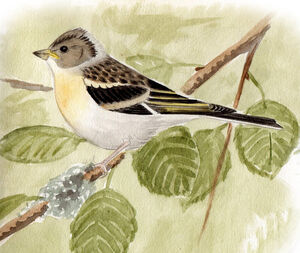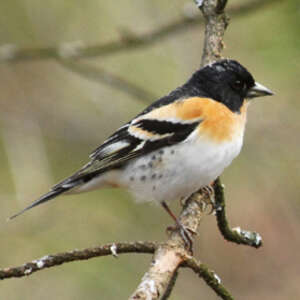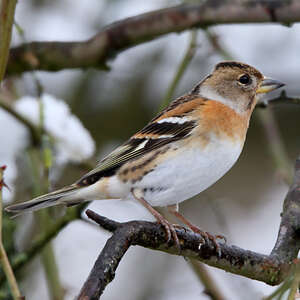Brambling
Fringilla montifringilla - Pinson du Nord
Identification
The Brambling of the North has the same size as the common Chaffinch which serves as a reference. It is usually a species which does not pose any identification problems. There is a sexual dimorphism, as is usually the case with finches. The species is monotypic, meaning that there are no subspecies. The adult male in breeding plumage can be recognized by the black cap covering his head and carrying on to the mantle and upper back and the beautiful orange colour covering his throat and the upper part of his chest and spilling over onto the wings. The white rump, a determining criterion, can only be seen when in flight. Finally, there is the typical call which will be discussed in the next chapter. This is enough for identification. One can also note the white belly and undertail, the sides speckled with dark brown, the dark eye, black beak and rosy legs. In winter, as we can see when the species winters with us, the male has lost the black on his head and back and resembles a female. Indeed, the feathers on these zones are edged with dark brown and fade to brown-grey. The sides and back of the neck are grey. The beak becomes yellow-lemon at the base. Compared to a female, the orange colour is more intense and the head darker. The eye is surrounded by a complete or incomplete beige eye-ring. The adult female resembles the male in winter plumage. The orange colour is however less pronounced. The face and sides of the head are more uniform and paler, brown-beige, which makes the dark brown lines on the sides of the crown more visible. The sides and back of the neck are grey. The beak is yellow, more or less darkened at the end. In winter, the plumage is very similar. We can simply note a paler beak and dark scapular feathers. The juvenile is female-like, with the feathers on the upper parts, from the crown to the back, largely edged in beige-ochre.This gives the head a speckled appearance and above the body, a scaly look. This plumage disappeared during the post-nuptial migration and is therefore not visible in temperate Europe. First-winter birds are very difficult to distinguish from older birds in winter. This depends on small details that we will not address.
Subspecific information monotypic species
Foreign names
- Pinson du Nord,
- Pinzón real,
- tentilhão-montês,
- Bergfink,
- fenyőpinty,
- Keep,
- Peppola,
- bergfink,
- Bjørkefink,
- pinka severská (ikavec),
- pěnkava jikavec,
- Kvækerfinke,
- järripeippo,
- pinsà mec,
- Fjallafinka,
- jer,
- ziemas zubīte,
- pinoža,
- Юрок,
- アトリ,
- 燕雀,
- นกจาบปีกอ่อนอกสีส้ม,
- 花雀〔燕雀〕,
Voice song and call
The common call is a very characteristic nasal tjeeeeh. This sound is how the presence of the Brambling is recognized throughout the year, and it is the sound made during flight. There are also keink keink... closer to the bird's vicinity. The alarm call near the nest is a pressed tsii. The song is a slow succession of slightly grating chuuuuus which undeniably resembles the equivalent phrase of a chaffinch.
Habitat
In the breeding season, Brambling occupy different types of northern woodlands, birch scrub, conifer and mixed forests, alluvial riparian alder, and the northern fringe of dwarf willows and birches.
Behaviour character trait
The most remarkable feature of the Brambling is its gregariousness. Once the breeding season is over, families gather together to carry out their activities.
When the late postnuptial migration begins - usually in October - flocks of migratory birds descend southwards in mono-specific or mixed flocks with other tree sparrows. Once in the wintering area, they still group together, forming large gatherings which manifest in dormitories. A beautiful dormitory can contain several million individuals as has been observed in Franche-Comté. During the day, the birds disperse into the forests, especially beech forests, within a radius of several tens of km to feed. In the evening, the troops converge to the dormitory where the movements of tens of thousands of birds above the dormitory forest are very spectacular. A photo in the gallery bears witness to this. Of course, this attracts predators, particularly Accipiters.Flight
Dietfeeding habits
The Brambling is an insectivorous and granivorous bird, depending on the season. On the breeding grounds, it consumes numerous land invertebrates of all kinds.
It hunts mostly in woodlands. The young are fed mainly on fly larvae. But it is also granivorous and the taxa of seeds it eats are as diverse as the animal taxa. On its migration and wintering grounds, it is obviously mainly granivorous and looks for the seeds on the ground. The most appetizing seed for it is beechnuts, the seeds of beech, and when the beeches have had a good fruiting season, many bramblings can feed themselves all winter in beech forests. The seeds of other trees, such as hornbeam, spruce, maple, pine, linden, etc., are also consumed in the forest. But the bird is not only found in forests. It also frequents fields where cereals and other escaped from the harvester are available. And cornfields are a great find for it just as for other granivorous birds. Its ration is around 11 g of seeds per day.Reproduction nesting
The breeding season is late, extending from May to August. The species is monogamous and territoral, which is not surprising given its extraordinary gregariousness during the inter-necting period.
The territorial male sings from a conspicuous perch and displays to the female by fluffing the head feathers and lowering its wings to show off the orange scapulars and puff up its white rump. It is the female's responsibility to build the nest, which is usually quite high up in a tree, conifer or deciduous, up to 15 m high, in a fork or against the trunk, but lower down in willow-birch scrub. The nest is a loosely-built structure of twigs, straw, dry grass, strips of bark and moss, held together with spider web and camouflaged with lichen on the outside. The lining is made of vegetable fibres, hair and feathers. The female lays five to seven pale blue eggs, lightly speckled with brown, which she incubates for 11-12 days, fed by the male. The nestlings, fed by both adults, stay inside the nest for 13-14 days before they fledge. Soon after the chicks leave the nest, the territoriality diminishes and the families tend to come together.Geographic range
The Brambling breeds from Scandinavia to the far east of Russia in the boreal forest continuum. It is a great migrator whose wintering area is in the south and separate from the breeding area, except for the milder Scandanavian Atlantic coast. The birds winter in Western and Southern Europe, in the Maghreb, in Western Asia, in the Middle East, from the south of the Caspian Sea to the Himalayan massif, in Eastern China and in Japan.
Threats - protection
Sources of information
- IOC World Bird List (v15.1), Gill, F and D Donsker (Eds). 2025-12-07.
- Finches and Sparrows, Peter Clement
- Les passereaux d'Europe, tome 2, P. Géroudet, M. Cuisin
- Avibase, Lepage Denis
- Birds of the World, The Cornell Lab of Ornithology
- xeno-canto, Sharing bird sounds from around the world,
Other sources of interest
 Specification sheet created on
17/07/2023 by Jean François
Specification sheet created on
17/07/2023 by Jean FrançoisTranslation by AI Oiseaux.net
© 1996-2026 Oiseaux.net
- Accipitriformes
- Aegotheliformes
- Anseriformes
- Apodiformes
- Apterygiformes
- Bucerotiformes
- Caprimulgiformes
- Cariamiformes
- Casuariiformes
- Charadriiformes
- Ciconiiformes
- Coliiformes
- Columbiformes
- Coraciiformes
- Cuculiformes
- Eurypygiformes
- Falconiformes
- Galliformes
- Gaviiformes
- Gruiformes
- Leptosomiformes
- Mesitornithiformes
- Musophagiformes
- Nyctibiiformes
- Opisthocomiformes
- Otidiformes
- Passeriformes
- Pelecaniformes
- Phaethontiformes
- Phoenicopteriformes
- Piciformes
- Podargiformes
- Podicipediformes
- Procellariiformes
- Psittaciformes
- Pterocliformes
- Rheiformes
- Sphenisciformes
- Steatornithiformes
- Strigiformes
- Struthioniformes
- Suliformes
- Tinamiformes
- Trogoniformes































